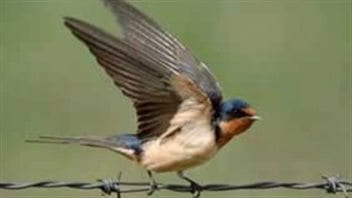For years a variety of environmental groups have been noting the decline of small grassland birds.
According to the Committee on the Status of Endangered Wildlife in Canada (COSEWIC), both bobolinks and barn swallows, once very common, are now listed as threatened species. Bobolinks have distinctive “R2-D2” like calls, while swallows are known to be extremely agile flyers.
A programme was begun this summer to get farmers on the maritime province of Prince Edward Island to create a bird friendly environment.
The swallows like barn rafters and eaves to make their mud nests, while bobolinks nest in the ground of uncut swatches dry hay, and grassland. The farmers who preferred not to have swallows indoors (because of the poop) had swallow-friendly roofed ledges added to the outside of their barns, and farmers with dry hay crops were asked to wait until July 7 to give bobolinks time to fledge the young. Farmers with unused grassland fields were asked not to mow them for two or three years.

Jackie Waddell, executive director of Island Nature Trust says 50 barn swallow nesting ledges were installed and 45 landowners agreed to keep their barns open during the birds’s nesting season, and says the programme has been a success. The idea is to increase populations by providing proper nesting habitats.
There has been a steady decline in these insect-eating birds for many years.
On its website COSEWIC says it’s partly due exposure to pesticides, to habitat loss and fragmentation, exposure to pesticides and loss of safe places for the birds to roost over winter.
In the east coast province of Nova Scotia for example barn and tree swallow populations have declined by 60 to 98 percent. The same is true in many other areas of the country
Another insectivore, the purple martin, no longer breeds in the province according to Blake Maybank who’s been watching birds in the province for 20 years.
Tara Imlay, a Dalhousie University PhD candidate in Halifax who has been studying the birds, thinks their scarcity might have to do with the insects they’re eating.
“I’m curious to find out whether or not these populations have declined as swallows are also declining, or if maybe, when insects are most abundant is no longer synced-up with when the swallows are breeding,” she said indicating climate change may be disrupting eons old patterns of nature.
In Ontario, developers are not happy with the birds’ status as endangered. In 2013, Leith Moore, president of the Ontario Home Builders’ Association said “It’s a big problem. The bobolink has become kind of a symbol for our current issues with the amendments to the Endangered Species Act.”
Moore had a housing development project in a township about 100 kilometres north of Toronto, that was held up because it encroached on bobolink habitat.
Farmers who rent land from developers say they won’t let them grow wheat, alfalfa or any other bobolink friendly crops.







For reasons beyond our control, and for an undetermined period of time, our comment section is now closed. However, our social networks remain open to your contributions.